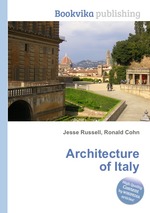Architecture of Italy
Jesse Russell Ronald Cohn
бумажная книга
High Quality Content by WIKIPEDIA articles! Architecture of Italy, often called Italian architecture, refers to all forms of this art in Italy. Italy has a very broad and diverse architectural style, which cannot be simply classified by period, but also by region, due to Italy`s division into several city-states until 1861. However, this has created a highly diverse and eclectic range in architectural designs. Italy is known for its considerable architectural achievements, such as the construction of arches, domes and similar structure during ancient Rome, the founding of the Renaissance architectural movement in the late-14th to 16th century, and being the homeland of Palladianism, a style of construction which inspired movements such as that of Neoclassical architecture, and influenced the designs which noblemen built their country houses all over the world, notably in the United Kingdom, Australia and the United States of America during the late-17th to early 20th centuries. Several of the finest works in Western architecture, such as the Colosseum, the Duomo of Milan, Florence cathedral and the building designs of Venice are found in Italy. Italy has an estimated total of 100,000 monuments of all varieties (museums, palaces, buildings, statues, churches, art galleries, villas, fountains, historic houses and archaeological remains).


